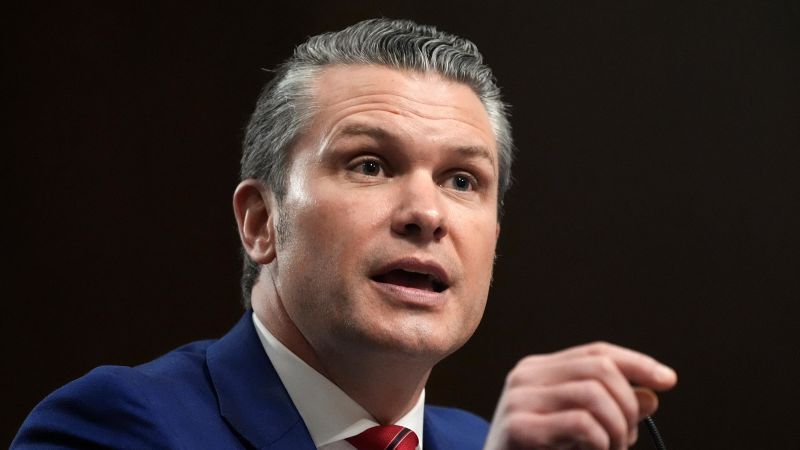
Fact Check Analysis: Vice President Vance Breaks Tie to Confirm Pete Hegseth
Today’s fact check was submitted by one of our DBUNK subscribers seeking clarity on a news article published by CNN on January 25, 2025, titled “Vice President Vance casts tie-breaking Senate vote to narrowly confirm Pete Hegseth as defense secretary.” Our subscriber wanted to know more about the truth behind Pete Hegseth’s confirmation and the implications of his so-called “warrior culture” initiative for the Department of Defense.
At DBUNK, we understand how confusing and overwhelming conflicting information can be in today’s media landscape. That’s why we’re here to provide clarity, cut through misinformation, and deliver unbiased fact checks. Let’s dive into the analysis.

Misinformation and Misrepresentation Found
The CNN article, written by Morgan Rimmer, Ted Barrett, and Manu Raju, discusses the highly contentious Senate confirmation of Pete Hegseth as Secretary of Defense. While the article provides a detailed recount of events surrounding the confirmation process, our fact-checking revealed elements of missing context, exaggeration, and potential bias. Let’s break this down in detail:
Claim: “Vice President JD Vance cast the 51-50 tie-breaking vote, marking just the second time in history a vice president has broken a tie for a Cabinet nominee.”
This statement is factually accurate, but it lacks context that could help readers better understand the broader significance of tie-breaking votes by vice presidents. While it is rare for vice presidents to cast tie-breaking votes on Cabinet nominees, vice presidents frequently step in to resolve deadlocks in the Senate (as provided for in Article I, Section 3 of the United States Constitution). For example, during his term, former Vice President Mike Pence cast 13 total tie-breaking votes, and Vice President Kamala Harris cast more than 25 tie-breaking votes at the time of her tenure ending. The statement could mislead readers into thinking these situations are almost unprecedented, which is misleading without proper framing.

Claim: “Hegseth’s confirmation process has been mired in allegations of sexual assault, alcohol abuse, and financial mismanagement of veterans’ charities, all of which he has denied.”
This statement is incomplete and omits key context about these allegations. Several credible reports and investigations, including an inquiry by the Department of Veterans Affairs, have documented concerns about Hegseth’s leadership in non-profit organizations supporting veterans. While it is true that Hegseth denies these allegations, the article does not mention that these claims have been corroborated in part by whistleblowers and watchdog groups. Omitting this critical information prevents readers from fully assessing the weight of the allegations against Hegseth.
For example, a 2022 ProPublica investigation highlighted mismanagement and self-dealing during Hegseth’s tenure with Concerned Veterans for America. Readers are left without a full understanding of the controversies tied to his leadership background. By not including this information, the article provides an incomplete profile of the nominee.

Claim: “As secretary, Hegseth has sworn to overhaul the department, particularly policies that he considers ‘woke,’ and streamline its bureaucracy.”
The use of the term “woke” is vague and politically charged, lacking a clear, universally accepted definition. Hegseth’s specific policy goals for “overhauling” the Department of Defense are not detailed in the article, leaving readers with an ambiguous understanding of what his agenda entails. During his confirmation hearing, Hegseth highlighted his focus on reducing perceived politicization within the military. However, critics have argued that his rhetoric about restoring a “warrior culture” represents a shift toward his own version of political influence over military practices.
Without clarification, the article risks oversimplifying his agenda and leaving readers with an unclear—and potentially misinformed—impression of what “warrior culture” means in practice. This term warrants further scrutiny, as it is central to his confirmation but remains undefined in the article.
Context for the Reader’s Question: What Does Pete Hegseth Mean by “Warrior Culture”?
Our subscriber asked how Pete Hegseth plans to define and implement the “warrior culture” he mentioned during his confirmation hearings. Based on available information, Hegseth has described this concept as a return to what he sees as traditional military values, emphasizing strength, discipline, and meritocracy. However, critics warn that his vision risks politicizing military policies by prioritizing ideological purity over inclusiveness and adaptability.
Hegseth has also criticized diversity and inclusion initiatives, arguing they distract from operational excellence. Yet, research conducted by the RAND Corporation and other defense think tanks supports the value of diverse teams for problem-solving and mission success. Without clear policy specifics, it is unclear how Hegseth’s proposed “warrior culture” reforms will align with evidence-based practices or address the U.S. military’s current challenges, such as recruitment and modernization.
Final Assessment
While CNN’s article delivers an engaging narrative on the confirmation of Pete Hegseth, it falls short in providing critical context and a balanced examination of the nominee’s controversies, qualifications, and policy proposals. A deeper dive into Hegseth’s past actions, verified claims of misconduct, and clear definitions of his goals for the Department of Defense would greatly enhance the article’s informativeness and credibility.
This serves as an important reminder for all readers to seek out additional sources and context when encountering politically charged stories. The DBUNK app is here to help clarify the noise and empower readers with the truth.


